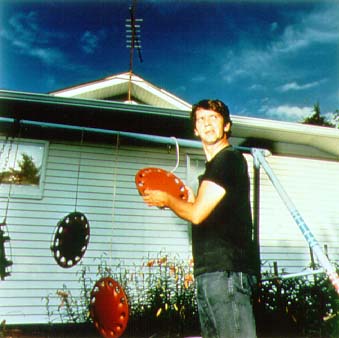Chris Verene, “Galesburg” at American Fine Arts, Co., 22 Wooster St., New York 10013

Unt (Galesburg)
1998 ed. 20 c-print 20 x 24 in., Chris Verene
The band DRI sang "I give a hoot but I still pollute" which seems to be the accidental position of Chris Verene with his "Galesburg" photographic series. Each photograph is of a friend or relative in the Illinois town, their importance to the world is captioned in a handwritten sentence or two across the top of the photograph. The people pictured are always troubled in one way or another. One fellow, sitting in a McDonalds, is living with his mother after his abused wife left him. Other people are living in a home for the mentally touched, or are just terribly old and can’t climb stairs. Verene is fixated on the aesthetic possibilities of the strangeness and misery of others, a fixation only equaled by his ability to find remarkably pleasant color schemes in the homes and haunts of his subjects.
Verene claims to be earnest with these photographs, that he lives with these people for years before making a photograph to represent them. Regardless of his intent, it seems that he is not so much interested in them as much as the novelty of their existence. Most of his subjects have rough looking lives, and Verene often captures them in moments that could be construed as sarcastic. Travis’s Grandma, for instance, is a photograph of a older woman wearing a sequined red dress and beaming with all the pride of a homecoming queen. She is in a run down kitchen, standing in front of the back door. The colors are very nice, and one gets an uncomfortable chuckle looking at her obvious happiness at having her photo taken in her most glamorous get-up. But is this really a respectful photograph? The photographer either has made or is helping Travis’s grandma look a bit foolish. I am sure Travis wouldn’t approve of the photograph.
The rest of the song by DRI goes on something like "Simulated sympathy In a world of pain, It’s each for his own if there’s something to gain." Even if Verene is as naive as to believe that most these photographs are not hurting his subjects, we have to ask what the viewer walks away with. And what sort of company do these photographs share in the world? Stylistically they have more in common with the later Gummo than Walker Evans. But Verene and Evans do share the desire to have their subjects framed in a very specific light, and carefully edit their photographs to make this vision happen.
The most suspicious note that sounds throughout the show is the pricing of the photographs. If the point of the show is intimate images of the artists friends, then why is it that the price list for the show tends to value the kitschier photographs over the simpler portraits? The odder Verene’s photograph the more it is expected to pull in, filling out Susan Sontag’s theory about the upper-class fascination with the misery of the sick and poor. Even if we assume that the artist took all of these photographs with a pure heart, the target audience is revealed in the prioritizing by the pricing of the images.
--End--
Chris Grega is an independent writer working in New York City; e-mail: chrisgrega@hotmail.com.
Chris Grega is